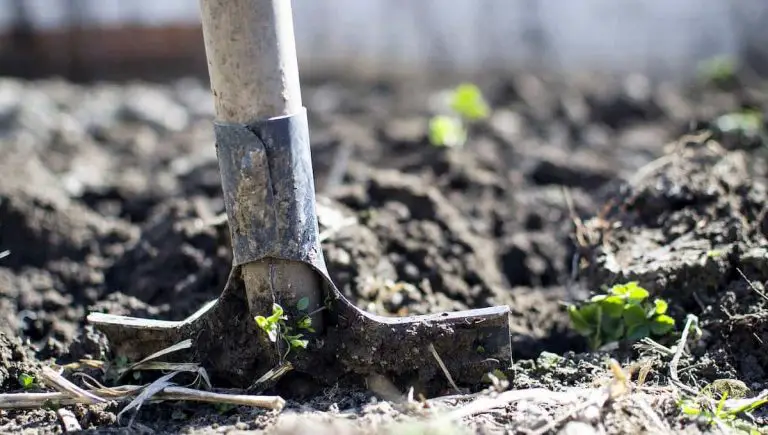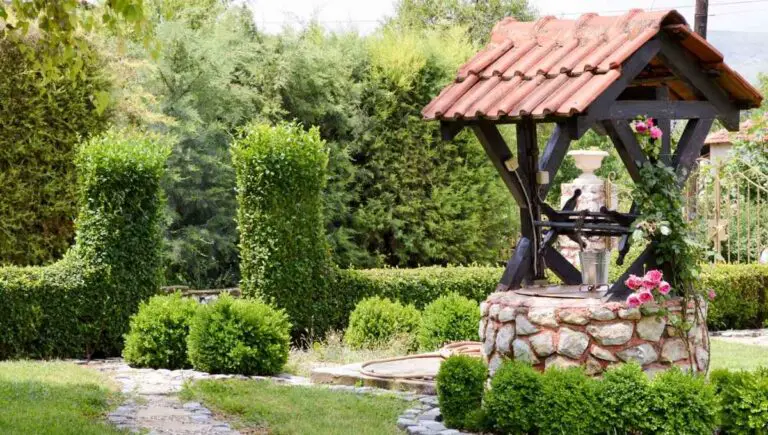Can I Dig a Pond on My Property? (You Need This First)

Ponds make excellent ecosystems and beautiful property features. So it’s no surprise that you want to install one, but before you begin, you need to know if you can legally dig a pond on your property.
Most areas allow you to dig a pond on your property as long as you have the required permits. Additionally, you need to ensure that your yard can support a pond, including enough clay soil and a nearby watershed.
But before you run out to your shed and pick up a shovel, read through this post to make sure you’ve considered everything so you can avoid some expensive mistakes. By the end, you’ll be glad you did.
This post contains affiliate links from Amazon and other stores. This means Yard Blogger may earn a commission if you make a purchase using any of our links. Please refer to our full affiliate disclosure policy for full details.
Here’s a Quick Pro Tip!
Once you have all of the necessary permits required to dig your pond, you can begin the excavation process! To make your job easier, we have compiled a list of helpful tools.
Here are some of our favorite excavating tools from Amazon:
1. Root Slayer Shovel – An amazing shovel that cuts through the toughest of yards
2. Jackhammer – For when you need to get past some rock
3. Wheelbarrow – A next-level wheelbarrow to clear debris easily
What You Need Before You Dig a Pond
Even if you decide to go the DIY route, you can’t just dig a hole for a pond. Half of the work of building is planning. So, the most important things you need to dig a pond are the necessary paperwork and permissions.
Obtaining permits can be a grueling process, but you’ll be glad you did it if the ax ever comes down on you.
Do You Need A Permit To Dig A Pond?
A small pond in your backyard purely for ornamental purposes likely won’t require a permit. However, a large pond that you plan to swim or have fish in will need a permit from the Environmental Protection Division in your state.
Your local Natural Resource Conservation Service (NRCS) office will be able to confirm if you need a permit to dig a pond or not.
If you have to apply for a permit, you need a permit to dig a pond because no one in the USA actually owns any of the water that flows on their property. All water is legally considered Waters of the United States.
Even ponds exempt from requiring permits still need to file for an exemption through the same organizations. This applies typically to ponds that serve agricultural purposes like irrigation or watering livestock.
Do I Need Planning Permission To Dig A Pond?
Some circumstances require planning permission to dig a pond. Consult with the United States Environmental Protection Agency to find out if your circumstance requires planning permission in the form of a permit.
Typically, when a pond has the potential to affect a waterway, the U.S. Army Corps of Engineers may need to give you federal approval to move forward with your plans- or to cancel them altogether.
Contacting the EPA will help you understand if there are any essential waterways near your home that your pond may potentially affect.
How Do You Get A Permit To Dig A Pond?
Your local law office will guide you to the right place to obtain a permit. From there, you can expect to fill out a form describing your project. You may have to discuss your project with several authorities and pay a determined fee.
I know it sounds like it can be a hassle but paying a permit fee now can save you from paying thousands of dollars in fines later if you are caught without a permit.
Doing it this way can also lead to guidance from a professional and finding good help with adequately installing your pond.
How Long Does It Take To Get Approval To Dig A Pond?
Depending on the project’s scope, it can take as little as 30 days or three months to get approval and obtain a permit. You can potentially get it sooner if you go to a specialist and they have connections with the right people.
It can take so long because your application may need an in-depth, technical review by engineers and biologists. Experts will be looking at reports and studies to see if the project is feasible while still taking care of the land.
What Is The Cost Of A Permit To Dig A Pond?
The cost of a permit to dig a pond can vary from $100-$2,000 depending on the size and necessary developments involved.
Paying the permit fee acknowledges that rules and regulations are being followed and for the amount of responsibility people need to take.
The more responsibility your project needs, the higher the cost due to payment of services.
You might also enjoy our post on The Best Koi Pond Plants for Your Backyard Pond
Is There A Penalty For Not Obtaining A Permit For A Pond?
You could face a penalty of $500 to $100,000 or more in fines and jail time of 30 days to one year. The larger your pond, the more likely it’ll be seen and reported and, thus, more severe penalties.
If you try to build a pond without a permit, the least that can happen is you’d be issued a “stop work” order. As the name implies, all work needs to stop so the necessary government agencies can review the project and make sure it follows laws.
Even if you manage to build your pond under the radar, problems will spring up when you go to sell or insure your property.
If anyone discovers that the work was not approved, insurance companies can drop coverage or deny claims, and potential buyers will be compelled to look elsewhere.
The worst that can happen is if it’s a large pond and the EPA finds out it was built without a permit. Then, they will not hesitate to charge you millions of dollars in fines and jail time if you cannot pay.
What Is Classed As A Large Pond?
There is no agreed-upon standard of pond sizes, but generally, anything less than one acre could be considered a pond.
It’s a little challenging to decide on the size difference of a pond versus a lake because you’re not just considering the surface area but also the depth.
Back when people were first naming bodies of water, they added: “pond” or “lake” in the name with nothing more than their own personal judgment.
This is how we have Echo “Lake” in Vermont, which is 11 feet deep, and Conway “Pond,” 80 feet deep.
Things to Consider Before Digging a Pond
Now that you know what you need to have before digging a pond, we need to go over a few other considerations. This section will tackle some common questions about what you should consider before digging a pond.
What Equipment Do You Need To Dig A Pond?
For a pond bigger than 800 gallons, you may need the help of a skid steer and backhoe and even a crane and loader. On the other hand, if your pond is smaller, you may only need some basic DIY tools like a shovel, spade, and wheelbarrow.
Tools:
- Something to mark the space before you start digging, like spray paint.
- Shovels and spades of different shapes or a backhoe for digging.
- A wheelbarrow or a loader to take the dirt away or bring some in if you need to add a specific soil type.
- Keep a measuring tape handy.
- A board to walk across to access the middle without loosening more dirt into it.
Supplies:
- A pond liner or clay sand to hold the water.
- Bricks, rocks, or plants for around the edges.
- If it’s a small pond, a pump, and a filter to keep it clean.
- You can add skimmers, heaters, lights, and aerators to go the extra mile.
- A garden hose to fill it!
Do I Have To Let My Neighbors Know I Am Digging A Pond?
If the pond you’re constructing will surpass the property line or if you share the flow of water with your neighbor, talk to your lawyer. Otherwise, there is no need other than common courtesy.
If your pond interferes with your neighbor’s property and you start altering the land, they can potentially sue you. Avoid trouble by talking to your lawyer.
If you can, give your pond lots of space away from any of your neighbor’s property to leave some room if it ever floods. An excellent way to avoid this is to have a trench or a place where the water can drain.
Do Ponds Need A Fence?
Rules around fencing ponds will vary, so check with your local authorities. Generally, ponds deeper than 18 inches should have a fence at least four feet tall entirely around it.
Apart from laws, if you’re worried a child or a pet will hurt themselves around your pond, getting a fence may be a good idea to put those worries to rest.
Even if a little person does manage to get past your fence, it’s an excellent way to stay out of trouble because you took the extra precaution.
How Deep Can A Pond Be Without A Fence?
A pond needs to be no deeper than 18 inches without a fence. However, it is best to check with the laws in your jurisdiction for a clear-cut answer.
Additionally, children and animals can drown in ridiculously shallow water so expect the minimum depth to be a low number. You may also have to consider a fence that children can’t climb over or slip through any gaps.
You might also enjoy our post on If You Can Dig a Well on Your Property
How Do You Build A Pond On Your Land?
To build a pond on your land, you must first obtain the appropriate permits. Doing so will help you avoid any legal implications that may arise in the future if your yard ever gets a professional inspection.
Here are some basic steps and guidelines on how to build a pond on your land:
- Building a pond starts with planning the size and type. Do you want a big or small one? Do you want to have fish and turtles? And most importantly, do you need a permit?
- You also have to pick a prime location. Far enough from your house to not cause water damage and far enough from your neighbor to not cause trouble.
- You will need a pond liner—the more durable, the more expensive.
- You will need a pump to keep water circulating. Ponds with waterfalls may even need two pumps. Aim for a pump that can circulate a gallon an hour.
- Get a filter to keep your water clean and clear. Choose one based on the volume of water in your pond and pick the best one for your pump.
- Get an aerator to oxygenate the water. They make your pond look even more beautiful and keep plants and fish happy.
- Now’s the fun part, decorations! The last step is the most satisfying by adding whatever creative flair you want.
Where to Dig a Pond
You can’t just put a pond anywhere. In fact, deciding where to put your pond will be half the battle because even if you have an idea of where it’ll go, you have to figure out the size, shape, and depth it’ll take. Let’s discuss.
How Far Should A Pond Be From A House?
Check with your local zoning department for exact guidelines but for a small pond, keep it about ten feet from your house, and for a large pond, 50 – 100 feet.
If you’ve ever bought a house, a home inspector will always tell you that you should keep all water away from your house. This is because even some harmless-looking water soaked into the ground can cause your foundation to shift and crack.
Fixing your foundation due to water can be very expensive. Avoid it at all costs. Consider adding some berms to redirect water if it overflows.
How Do You Build A Pond In A Wet Area?
First, find out if you’re allowed to dig a pond in a wet area because it may be part of a protected wetland. If you are, dig a spot in the lowest part of your yard. Line it with pond liner, cement, or clay and fill it with water.
If digging a pond wasn’t complicated enough for you, it gets substantially more complicated if it’s on wet land. Every situation will be unique, and the best course of action would be to get specialized help.
Can You Put A Pond In Your Front Yard?
You can indeed put a pond in the front of your yard, but if it’s deeper than 18 inches, it will have to be fenced for safety reasons. Additionally, check with your HOA – if you have one – to find out a pond is within regulations.
If you’re putting your pond at the front of your house, it’s still a good idea to keep it as far from the house as possible to prevent water damage.
Also, it may not attract as much wildlife because the front yard can be a busy place.
Can You Build A Pond In Your Backyard?
You can build a pond in your backyard but check with your local laws to determine if it will need a fence and a permit before beginning your building process.
The back of the house is the most common place to build a pond and probably the best. The backyard is more likely to be fenced, less likely to be disturbed by a stranger, and easier to see from the house.
How Many Acres Do You Need For A Pond?
Ponds are versatile and can be built in even the tiniest yards–less than .05 of an acre. The best advice would be to consider how much space you have and build accordingly.
Don’t let the size of your property stop you from enjoying a little water. Even in small apartments, you can buy or build tiny ponds.
For large ponds, always leave space for flooding and a place to drain no matter how many acres you have.
Cost and Maintenance of a Pond
Of course, it’ll take some money to build your beautiful pond and, like everything else around your house, it’ll cost some money to maintain it. Here we’ll answer some questions to shed some light on the numbers you can expect.
What Does It Cost To Dig A Pond?
The average cost to build a pond is about $9,000 but ranges from $5,000 – to $20,000. The cost varies by type of pond, soil, liners, if you need permits, and of course, size.
There is honestly no way to put an actual number on it because so many factors go into cost. But here are a few general ideas:
- An ornamental pond with a plastic liner and no landscaping will be on the low end of just under $2,000.
- A koi pond with a rubber liner and landscaping will be closer to $10,000
- Anything larger with a concrete liner and regeneration zone will be well over $20,000.
You might also enjoy our post on If You Can Put a Pool in Your Front Yard
How Much Does It Cost To Build A One-Acre Pond?
A one-acre pond can cost between $3,000 to $5,000 to install. Adding fish and landscaping around the edge will cost more.
Although you may be tempted to do it yourself to save money, if you mismanage equipment and materials, you could spend more than if you hired some help.
How Do You Maintain A Pond?
Surprisingly, maintaining a pond can be more work than installing it. It involves many regular maintenance checks and constant repairs.
Maintenance means:
- Regularly cleaning your pond.
- Cutting back nearby plants that want to take over.
- Growing water plants.
- Managing ice in the winter.
- Keeping algae growth in check.
- Regularly checking mechanical equipment like pumps and filters.
- There will be leaks!
- Keeping an eye on the water level.
- Keeping an eye on the temperature.
- Aeration.
- Keep your water chemistry in check.
The last thing you want is all your hard work to be ruined by wear and tear. So, even if your pond is as natural as possible, there are still ways you can and should keep it clean.
Maintenance begins as soon as it’s completed construction because if you don’t, it will turn into an unhealthy addition that does more harm than good in your yard.
Related Questions
How Deep Should My Pond Be To House Fish?
Your pond should be deep enough so it doesn’t freeze in the winter. For example, 18 inches is usually sufficient, but you may need 30 inches for really cold areas.
Ideally, you will want to give your fish as much room as possible, and some sources will say two feet deep minimum. Take into consideration what zone you live in, how many fish you want, and how big, and plan accordingly.
How Many Fish Can I Put In A Pond?
A good rule of thumb for how many fish you can put in a pond is 10 gallons for every 1 inch in fish length. However, this can be difficult to calculate because the size and type of fish vary so much.
If you have koi fish, remember that they can grow 30 inches long which means you’ll need 300 gallons of water for just one fish. If you want more, goldfish can be kept in tighter spaces easier.
If you want others to grow, you may have to consider culling your fish flock, so oversee your numbers.
Final Thoughts
By now, we are sure your creative juices are flowing and you are ready to start installing your pond. Just ensure that you obtain all of the necessary permits so you can go about things legally.
Doing so will save you stress and money in the long run if you ever get caught without the legal requirements.










